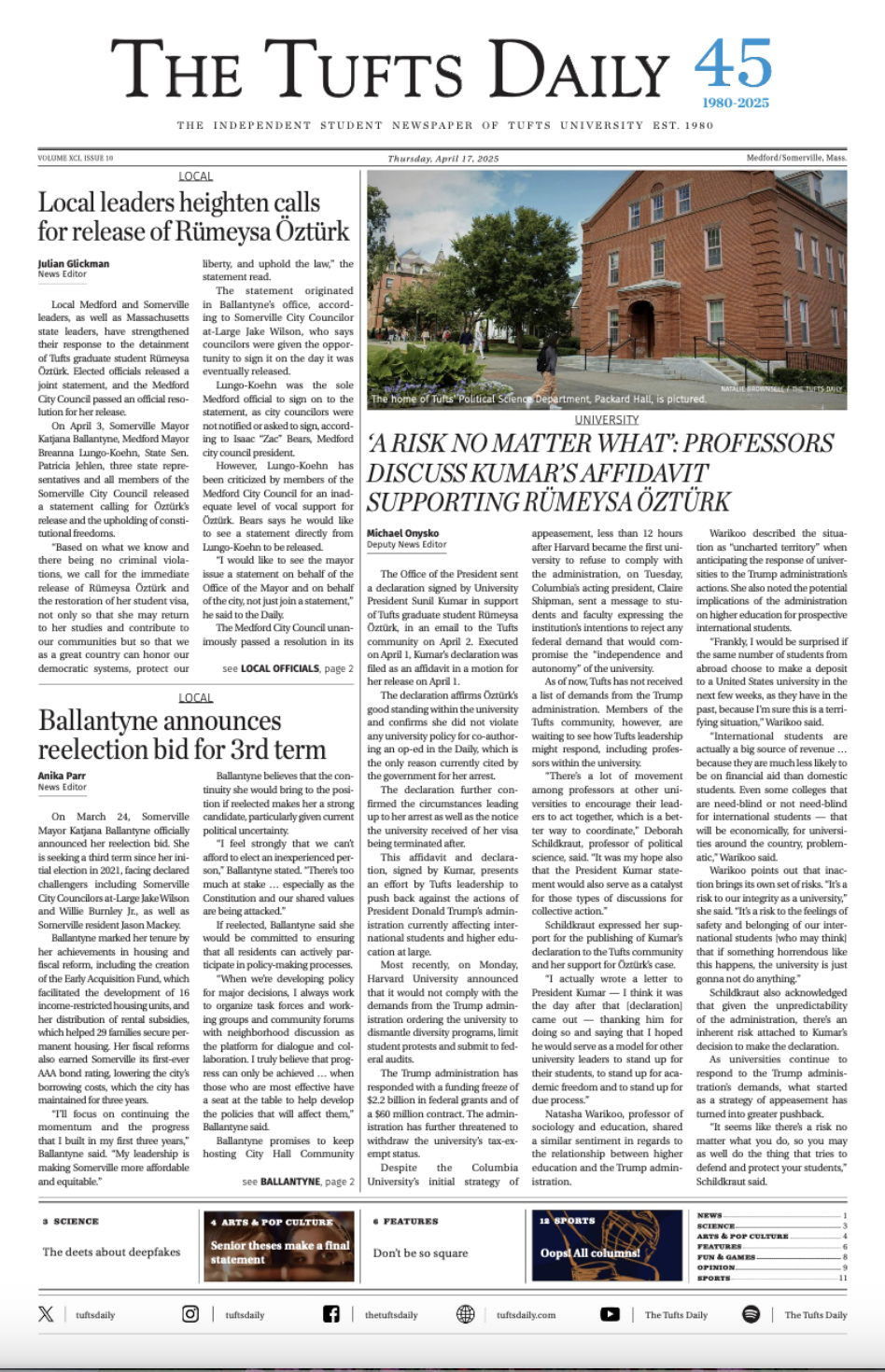It seems that Tufts' student-driven environmental focus extends well beyond the Hill. Jumbo involvement in environmental efforts such as the "Think Outside the Bottle" campaign and Tufts' Environmental Consciousness Outreach falls in step with a Massachusetts-wide focus on larger environmental goals.
A report released last week showed "substantial potential" for the state to develop its own renewable energy over the next decade. The 114-page study, conducted by Navigant Consulting, estimates that the state is capable of using assorted materials and technologies to produce about 10 million megawatt hours of clean power by 2020, surpassing the goals laid out in the Green Communities Act.
The act, signed into effect in July 2008 by Gov. Deval Patrick (D), has called for a Renewable Portfolio Standard that grows by one percent per year, reaching 15 percent in 2020 — or about 7.5 million megawatt hours. The standards of the act initially caused concern that Massachusetts would have to import power from other states to meet requirements, as it has in the past.
But the study suggests that Massachusetts will not necessarily be forced to look outside its borders to comply.
"[It makes] it clear that there are really sound choices that we can make as a state that will set us up for a very progressive future," said David Barclay, executive director of the Northeast Sustainable Energy Association.
While individual studies with a narrower focus exist, this marks the first comprehensive look at in-state solar, wind, biomass, river and ocean resources, according to Vivek Mohta, director for energy reliability and markets for the Department of Energy Resources (DOER).
Looking at a variety of scenarios, the report, commissioned by the DOER and the Massachusetts Renewable Energy Trust, assessed the theoretical, technical and economic potential from all five resources. Wind and solar power demonstrated the largest technical and long-term economic potential: Highly accessible resources, they will eventually be more cost-effective than current energy projects.
"As the price of fuel continues to climb, there will be an increasing interest in clean renewable energy as an alternative to fossil fuel sources," Barclay said. "It's both a pocketbook issue and one that makes good sense from an environmental standpoint."
But Jeremy McDiarmid, a staff attorney for Environment Northeast, was unsure about the feasibility of the study's conclusions, noting that the theoretical, technical and economic markers are lacking a companion indicator.
"There should be a fourth category of achievable potential, which is probably a little bit less than the economic potential," he said.
McDiarmid said the goals are possible, but not without a good deal of work. "It's going to take a lot of commitment on the part of the state and the stakeholders to make it happen," he said.
The report singled out governmental incentives as a highly important but highly uncertain factor in deciding how much clean power is produced in the state. Since securing a permit is difficult, political help is sometimes needed in order to create new energy facilities.
The commonwealth's Green Communities Act addressed this and other problems by creating an Energy Citing Commission "to study the citing of energy facilities in the state ... and streamline the permitting process," said Mohta, who believes the commission will start to have a big impact over the next few months.
Incentives were also added on a local level to help simplify the permitting process in cities and towns.
Currently, projects under construction, design or consideration, if approved and completed, will account for 3.7 million megawatts of power, leaving a minimum of 3.8 million to be found from new projects by 2020.
Mohta believes that an increased interest in Massachusetts from stakeholders nationwide involved in renewable energy will come in step with the release of the study. "It lets them know that there are a lot of untapped resources," he said. "We expect that those will be pursued.
The study comes at the end of a wave of four other environment-related pieces of legislation passed and signed into effect in Massachusetts in the past two months, in addition to July's Green Communities Act and May's Ocean Act, which dealt, in part, with oceans as a renewable resource.
"We need to work through those and see where that gets us," Mohta said. "Of course, there are going to be other things that are considered in parallel, [but] the action that's been taken this year really puts us in a good place to move quickly."
While Anja Kollmuss, associate researcher at the Stockholm Environment Institute's US Center in Medford, described the recent legislation and survey as an "interesting and important first step," she emphasized that it is an elementary step.
"It's no way near the kinds of reductions we have to make if we want to … keep climate change to a minimum," she said.





